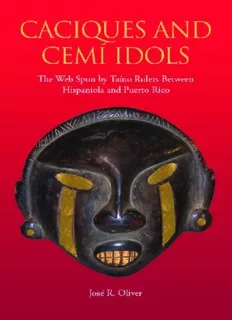
Caciques and Cemí Idols: The Web Spun by Taino Rulers Between Hispaniola and Puerto Rico (Caribbean Archaeology and Ethnohistory) PDF
Preview Caciques and Cemí Idols: The Web Spun by Taino Rulers Between Hispaniola and Puerto Rico (Caribbean Archaeology and Ethnohistory)
Caciques and Cemí Idols CARIBBEAN ARCHAEOLOGY AND ETHNOHISTORY L. Antonio Curet, Series Editor Caciques and Cemí Idols The Web Spun by Taíno Rulers between Hispaniola and Puerto Rico José R. Oliver THE UNIVERSITY OF ALABAMA PRESS Tuscaloosa Copyright © 2009 The University of Alabama Press Tuscaloosa, Alabama 35487-0380 All rights reserved Manufactured in the United States of America Typeface: AGaramond ∞ The paper on which this book is printed meets the minimum requirements of American Na- tional Standard for Information Sciences-Permanence of Paper for Printed Library Materials, ANSI Z39.48-1984. Library of Congress Cataloging-in-Publication Data Oliver, José R. Caciques and Cemi idols : the web spun by Taino rulers between Hispaniola and Puerto Rico / Jose R. Oliver. p. cm. — (Caribbean archaeology and ethnohistory) Includes bibliographical references and index. ISBN 978-0-8173-1636-5 (cloth : alk. paper) — ISBN 978-0-8173-5515-9 (pbk. : alk. paper) — ISBN 978-0-8173-8117-2 (electronic) 1. Taino Indians—Religion. 2. Taino Indians—Implements. 3. Taino Indians—Colonization. 4. Indians of the West Indies—First contact with Europeans—Hispaniola. 5. Stone implements—Hispaniola—History. 6. Icons— Hispaniola—History. 7. Christianity and culture—Hispaniola. 8. Christianity and other religions—Hispaniola. 9. Religious syncretism—Hispaniola. 10. Spain—Colonies—America. 11. Hispaniola—Colonization. 12. Hispaniola—Antiquities. I. Title. F1619.2.T3O55 2009 972.9′02—dc22 2008038785 Special Credits Front Cover Illustration: A close-up of the face of a cemí idol recovered from a cave site in Car- penters Mountain, Jamaica (Cat. AM 1977. Q1). For this portraiture the head was cropped to highlight the personage’s facial features; the gold sheet eye and lachrymal inlays and the shell- denture inlays were digitally added to render a likely interpretation of what the face might have looked like had the inlays been preserved. Photograph and digital additions with Adobe Photo- shop by José R. Oliver. ©The Trustees of the British Museum. Back Cover Illustrations: A three-pointed stone cemí from Puerto Rico. ©Museo de Historia, Arte y Antropología–Universidad de Puerto Rico. Author’s photo (inset back cover). Photograph of the author at the Bateyes de Viví (U-1) site, Barrio Viví Arriba, Utuado, Puerto Rico (2005). To my daughter, Juliana, for the joy she brings to my life, and to my wife, Kim, my guardian angel Contents List of Illustrations and Tables ix Preface xiii PART I. INTRODUCTION AND THEORETICAL PREMISES 1. Introduction 3 2. Believers of Cemíism: Who Were the Taínos and Where Did They Come From? 6 3. Webs of Interaction: Human Beings, Other Beings, and Many Things 43 4. Personhood and the Animistic Amerindian Perspective 48 5. Contrasting Animistic and Naturalistic Worldviews 53 PART II. THE FORM, PERSONHOOD, IDENTITY, AND POTENCY OF CEMÍ IDOLS 6. The Cemí Reveals Its Personhood and Its Body Form 59 7. Cemí Idols and Taínoan Idolatry 64 8. Cemís and Personal Identities 67 PART III. THE SOCIAL RELATIONS AND CIRCULATION OF CEMÍ IDOLS AND HUMAN BEINGS 9. The Power and Potency of the Cemís 73 10. The Display of Cemís: Personal vs. Communal Ownership, Private vs. Public Function 77 11. Face-to-Face Interactions: Cemís, Idols, and the Native Political Elite 83 12. Hanging On to and Losing the Power of the Cemí Idols 87 13. The Inheritance and Reciprocal Exchange of Cemí Icons 103 viii Contents 14. Cemís: Alienable or Inalienable; To Give or To Keep 109 PART IV. STONE COLLARS, ELBOW STONES, THREE-POINTERS, STONE HEADS, AND GUAÍZAS 15. Stone Collars, Elbow Stones, and Caciques 121 16. Ancestor Cemís and the Cemíifi cation of the Caciques 141 17. The Guaíza Face Masks: Gifts of the Living for the Living 148 18. The Circulation of Chiefs’ Names, Women, and Cemís: Between the Greater and Lesser Antilles 157 PART V. THE BATTLES FOR THE CEMÍS IN HISPANIOLA, BORIQUÉN, AND CUBA 19. Up in Arms: Taíno Freedom Fighters in Higüey and Boriquén 191 20. The Virgin Mary Icons and Native Cemís: Two Cases of Religious Syncretism in Cuba 221 21. Religious Syncretism and Transculturation: The Crossroads toward New Identities 232 PART VI. CONCLUSIONS 22. Final Remarks 247 References Cited 257 Photo Credits and Copyrights 281 Index 287 List of Illustrations and Tables List of Illustrations 1. Map of the Caribbean showing the circumscribed area of the distribution of four classes of cemí icons 91 2. A selection of three-pointed stone cemís from Hispaniola (a-i) and Puerto Rico (j-m) 91 3. Stone collar, elbow stones, and Macorís stone heads 92 4. Distribution of cultures and peoples according to Irving Rouse at the time of Columbus (A.D. 1492–1520s) in the Greater Antilles 92 5. The standard cultural chronology of the Windward Passage, Mona Passage, and Virgin Passage areas in the Greater Antilles 93 6. Ceramic bowls used for inhaling hallucinogens 94 7. Devices for inhaling hallucinogens (Periods III–IV) 94 8. Spread of calibrated radiocarbon dates (2 sigma) associated with Rouse’s ceramic styles (Cuevas to Santa Elena) 95 9. The “decapitated” (?) personage found in the main plaza of Jácana (PO-29), Ponce, Puerto Rico 95 10. An example of the dual natures of a “frog-human” personage modeled in ceramic, hanging on and looking into a Santa Elena–style open bowl from Vacía Talega site, Puerto Rico 96 11. Wooden cemí idols involved in cohoba ceremonies 96 12. Petroglyphs and pictographs are here interpreted as a class of nonportable cemí icons 97 13. A diverse sample of small cemí artifacts used for body decoration or for personal use from the Dominican Republic 98 14. Three-pointed stone cemí with detailed anthropomorphic facial features that lend it identity and personhood, from the Turabo Valley, Caguas, Puerto Rico 99
